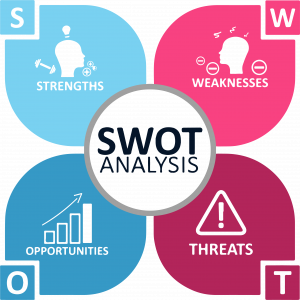
How to Conduct a SWOT Analysis of a Competitor
A SWOT analysis of a competitor will help you focus on the external and internal factors that affect your business. It will also help you understand the business of your own company or establishment. This process will help you create an action plan for implementing a competitive advantage strategy. You can learn more about SWOT analysis from this article. It is a useful tool for any business owner, whether you’re planning to start a new venture or grow your existing business.
Strengths
The SWOT analysis consists of four elements, or subgroups of factors: threats, opportunities, and weaknesses. The strengths and weaknesses of a company are internal factors, while its opportunities are external forces, such as those of its competitors. Identifying the internal and external factors that affect a company’s performance can help it formulate a strategy for maximizing its advantages. By identifying the strengths and weaknesses of a competitor, it can better understand its position in the market and create strategies to overcome them.
When identifying the strengths of competitors, it is important to identify the competitive advantages that separate the company from the rest of the field. For example, a hedge fund may have its own proprietary trading strategy. Once it has analyzed its competitors, it must decide how to use the results to attract new investors. These are all strengths that differentiate an organization from its competitors. In addition to the attributes of products and services, the company’s strengths can also include prior experience.
While a SWOT analysis can be valuable for CI efforts, it is often not enough to determine the strengths of a competitor. Depending on the nature of your business, a SWOT analysis can provide valuable insights into your own strengths and weaknesses. It is also a great way to determine a competitor’s strengths, which can help you find the sweet spot for your business. This approach should be incorporated into any business strategy to help you make the right decisions.
As you can see, a SWOT analysis can be very useful for assessing the competitive position of a company. It can identify a company’s internal strengths and weaknesses, as well as its external factors, including its competitors and raw materials. By identifying these factors, a business can better plan for its future and improve its performance. In addition, a SWOT analysis will help you develop a better strategy by identifying the factors that affect the market share of competitors and other companies.
Once you’ve analyzed the external factors of a competitor, you can use the results of the SWOT analysis to develop a more effective strategy for your own business. SWOT analysis is a great tool to use in competitive analysis, and it can help you improve your business by improving your team. Ultimately, it will help you see where you should focus your efforts and what your competitors need to do to improve.
Weaknesses
A competitor SWOT analysis focuses on both external and internal factors that affect a business. It can help you focus on the business of a specific establishment or company. For example, if you’re in the food industry, you’ll want to look at the competition in the area of food services. Then, you’ll need to look at what they’re doing to stay ahead of the game.
A SWOT analysis includes four elements and subgroups, known as strengths, weaknesses, opportunities, and threats. Strengths and weaknesses are internal factors that affect a business. Weaknesses, on the other hand, are factors that prevent a business from achieving its goals. Listed below are examples of the strengths and weaknesses of a competitor. If you’re considering a competitor, you’ll need to be honest about your weaknesses.
Your company’s strengths and weaknesses can sometimes be external however being internal factors. Internal strengths include things like company culture and financial resources, while external strengths include emerging competitors and monetary policies.
Examine your strengths and weaknesses to determine which of them will help you achieve your business goals. Then, consider what opportunities they present. Each strength should have an equal opportunity to succeed. Then, determine how to leverage your strengths to make them work in your favor.
You can conduct SWOT analysis in a private setting, which is more effective than a group brainstorming session. The private SWOT analysis also avoids groupthink and makes sure that each person’s voice is heard. Then, group your notes into similar categories and add new notes as necessary. Ultimately, you’ll have a clearer idea of which factors will help your business grow. For example, you can make changes or adjustments based on SWOT analysis results.
The benefits of SWOT analysis are numerous:
- The process of SWOT analysis helps you identify your strengths, weaknesses, opportunities, and threats.
- It is a highly effective strategy tool and can help you develop an efficient plan for your business.
- You can use it to make better decisions and develop better teams.
- You can also use it to stay ahead of the market trends.
- By doing a SWOT analysis, you can identify which areas of your business need improvement and how to prioritize your efforts.

Opportunities
As we mentioned before SWOT analysis is a method of assessing a company’s strengths, weaknesses, opportunities, and threats. Each factor represents an internal or external factor. The Strengths of the organization are internal positive aspects that contribute to its success. The Weaknesses are internal negative factors that may hinder its efforts to achieve its goals. The Opportunities are the other three elements. Once these are identified, the company can develop strategies to capitalize on them.
When determining the strengths and weaknesses of your competitors, you must also look for opportunities. This is where the opportunities in competitor SWOT analysis come in. These are the opportunities that you can use to grow, expand, acquire, or partner. CI activities provide this data. The benefits of competitive SWOT analysis can be realized if you know where to look. Keeping a close eye on your competition does not have to take up a lot of time, either. You can set up Google Alerts to stay up-to-date on what competitors are up to.
The advantages and disadvantages of each company are also identified. You can use the results of this analysis to develop roadmaps for strategic planning. These roadmaps can be useful for many purposes, from creating budgetary plans to hiring new employees. They are also used by financial analysts to assess a company’s creditworthiness. They help them formulate a realistic and measurable plan. Once you’ve identified your company’s SWOT, you can begin identifying opportunities.
While SWOT analysis is a useful tool for identifying opportunities and weaknesses, it is important to apply it correctly. This means using the correct SWOT analysis at the right level of your company, including the product line level or organization. Additionally, SWOT analysis is an excellent tool to use alongside other strategic tools. It can also help you determine the priority areas to target. If done properly, SWOT analysis can provide vital information for communication and planning.
The threats and opportunities in a competitor’s SWOT analysis are external factors that may negatively affect the company. They are usually acknowledged with a plan to overcome them. Some examples of threats include a changing industry landscape, negative technological developments, and decreasing TAM and product appeal. To make the most of SWOT analysis, you must do your research and make it as attractive as possible. However, it’s worth noting that a SWOT analysis is often part of larger business analysis and can be an effective summary of other findings.
Threats
If your business is unable to compete with your current competitors, you may have to take a look at your own market dynamics to see if you can outwit them. Your 30,000-foot view can help you anticipate potential moves by competitors, as well as respond to potential opportunities. In addition to financial threats, competitors can be a source of market trends and changes. Here are some common threats you may face:
When evaluating your own business, you will find that your competitors have several strengths and weaknesses that you can leverage to your advantage. By examining your strengths and weaknesses in this way, you can identify where you can exploit those strengths while simultaneously counteracting the weaknesses. Even if you do not have the time to keep a close eye on your competition, you can use Google Alerts to stay on top of their latest updates. You can also follow them on social media including FaceBook and Twitter to receive notifications when they make important announcements.
The strengths and weaknesses of your competition are crucial to your business’s success. A strong competitor may have more advantages and better products and services than you do. However, your competition is likely to have some disadvantages, making them more likely to attack your market share and your business. Your company must consider these in your competitive analysis. The threats you face maybe your own internal resources or your competitors’. In either case, if you can overcome these threats, you can win the game.
One way to counter these threats is to increase the efficiency of your internal operations. Make sure to include your employees and suppliers in your SWOT analysis. Employees are also key to business success. You should make use of resources available to your business and be proactive, rather than reactive. In order to avoid being left behind, you should always be aware of your competitors. By identifying their weaknesses, you can better understand what your competitors are doing.




